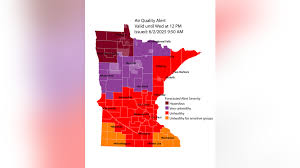As wildfires continue to rage across Canada, the impact is being felt as far as Minnesota and Michigan, with air quality alerts in place due to the smoke drifting southward. The Canadian Interagency Forest Fire Centre reported over 180 fires actively burning, with a significant portion of them out of control, scorching more than 3.7 million acres of land since the beginning of the year.
Minnesota has been particularly affected, with hazy skies and poor air quality prompting the state's Pollution Control Agency to issue alerts. The smoke has led to an "unhealthy" air quality rating in central and southern Minnesota and the Arrowhead region, while conditions are labeled as "hazardous" in far northwest Minnesota. These conditions can cause irritation to the eyes, nose, and throat, along with symptoms such as chest tightness, shortness of breath, and coughing.
The situation is no different in Michigan, where the National Weather Service has cautioned residents about fire risks due to the smoke. In South Carolina, the haze from Canadian wildfires resulted in a unique "red sunrise." Sensitive groups, including pregnant individuals, newborns, older adults, and those with respiratory or heart conditions, are advised to minimize outdoor activities to avoid the effects of poor air quality.
As the smoke continues to drift into the United States, states like Texas, Michigan, and Pennsylvania are being impacted. The Pennsylvania Department of Environmental Protection has warned of hazy skies in the southwestern part of the state and advised residents to stay informed, especially if they have respiratory concerns.
In Canada, the situation remains dire, with over 25,000 residents evacuated as wildfires rage on, burning over 1.58 million acres. Canadian Prime Minister Mark Carney has mobilized armed forces to aid in air evacuations in Manitoba. The impact of these fires is far-reaching, not only affecting air quality but also posing significant challenges to firefighting efforts and the safety of communities.
Despite the challenges posed by the wildfires, meteorologists offer a glimmer of hope, highlighting that much of the smoke remains aloft and may not significantly impact air quality closer to the ground. While the smoke may create a milky appearance in the sky and vibrant sunrises, the effects on air quality might be less severe than feared.
The complex interplay of weather patterns, wildfires, and air quality alerts underscores the urgency of addressing climate change and proactive wildfire management strategies. As smoke continues to billow from the Canadian wildfires, the importance of collective action to mitigate the impacts of such environmental crises becomes increasingly evident. Stay informed, stay safe, and join the global effort to combat climate change for a healthier future.

